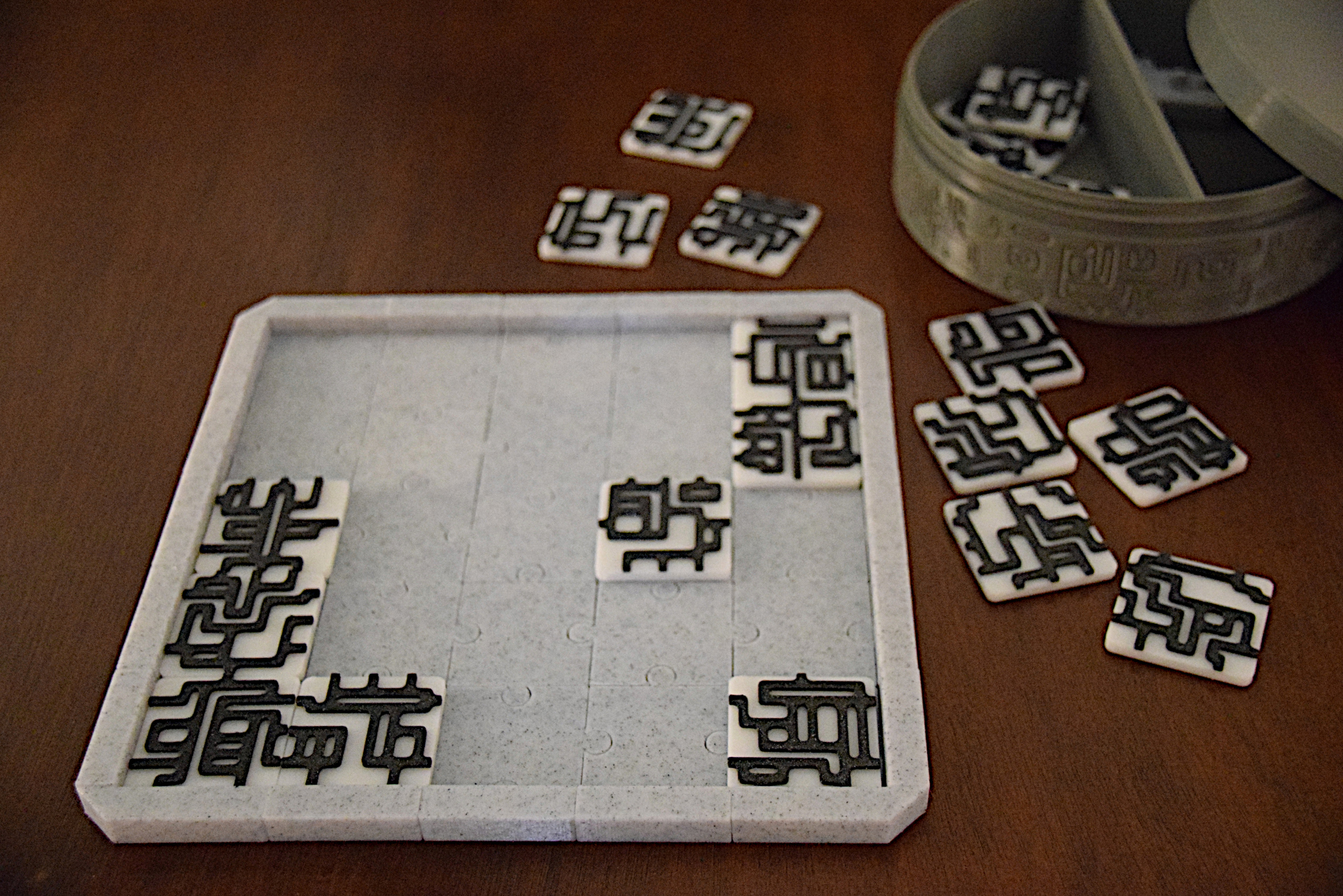
Garden of Forking Paths (Tile placing board game / puzzle)
prusaprinters
<p>A game inspired by the MacMahon squares, a puzzle published by Percy MacMahon in 1921. In its original version, the game consists of 24 unique three-coloured square tiles which must be placed on a 6x4 board in a way such that all adjacent edges are of the same colour.</p><p>Here we have replaced the three colours with 3 connection types which match fully or partially, enabling more variations in rules and difficulty. The tile patterns have been generated with the help of the wavefunction collapse algorithm, and are designed to give rise to complex maze-like structures while you play.</p><p>A modular board and a container make the game easy to carry around; you only need a flat surface to play.</p><p>Generally, the objective is to find tile placements satisfying constraints on matching edges, as well as limits on which edges can occupy certain locations (e.g. the board perimeter can only have a single connection type leading to the outside world).</p><p>Below are a few such games:</p><p> </p><p><strong>Single Player Puzzle (5x5 or 6x4 board)</strong></p><p>The objective is to arrange all 24 tiles on a 6x4 or 5x5 board ensuring all adjacent connections fully match. For a more challenging experience, ensure the perimeter consists of a single connection type.</p><p> </p><p><strong>Two Player Board Game (5x5 or 6x4 board)</strong></p><p><i>Variation A</i></p><p>Players take turns placing 12 tiles each, ensuring all adjacent connections fully match, as well as maintaining a perimeter consisting of a single connection type. Each newly placed tile must share an edge with a tile already on the board. The first tile placed on the perimeter determines the perimeter connection type. The last player able to place a tile on the board wins.</p><p><i>Variation B</i></p><p>Players take 12 tiles each and pick a connection type. Their objective is to place as many connections of their choice at the perimeter as possible, while ensuring all edges fully match. Each newly placed tile shares an edge with a tile already on the board. The game ends when no more tiles can be placed. The player whose connection of choice appears more times on the perimeter wins.</p><p> </p><p><strong>Multiple Players (no board)</strong></p><p>Players take turns drawing a tile from the heap and placing it next to an already placed tile, ensuring connections between adjacent edges match at least partially: for example a side with 3 connections can be placed next to a side with one or 2 connections. Every placement is scored based on the number of edges connected, and whether the connections match fully or not (one point per connected edge and one point per fully matching connections). When all tiles have been placed, the player with the highest score wins. There are no restrictions on the overall shape of placed tiles. If a player draws a tile that cannot be placed, they put the tile back on the heap and draw another. Printing additional tilesets makes the game more fun with 3 or more players.</p><p><br><strong>Creative mode</strong></p><p>Create mesmerizing patterns or even entire artworks and hang them on a wall just like a conventional puzzle! Mix and match the rules above, extend the board, print more tilesets, or add your own constraints for tile placement.</p><p> </p><p> </p><p><strong>INSTRUCTIONS</strong></p><p>Everything prints at 0.2mm layer height.</p><p>To print a tile, import <code>tile.stl</code> and then import a pattern as a part. The base is 3 mm high, while the pattern is 1 mm high. When printing with a single nozzle, you can add a colour change command at the 3.20 mm mark to print the pattern in a different colour. This is done for all tiles in <code>puzzle-pieces_i3_prusaslicer2.3.0.3mf</code>, which you can adapt to your printer and filament.</p><p>For the boards you will need:</p><ul><li><code>board-tile.stl</code>: 25x</li><li><code>board-border-hole.stl</code>: 10x</li><li><code>board-border-tab.stl</code>: 6x</li><li><code>board-border-corner1.stl</code>: 4x (2x for the 5x5 board, 4x for the 6x4 board)</li><li><code>board-border-corner2.stl</code>: 2x (for the 5x5 board)</li></ul><p>The project file <code>board-borders_i3_prusaslicer2.3.0.3mf</code> contains all pieces required for the board borders.</p><p>The naming scheme for the patterns follows the convention on Wang tiles (of which MacMahon squares are a subset) outlined here:</p><p><a href="http://www.cr31.co.uk/stagecast/wang/puzzle.html">Puzzle Tilesets (cr31.co.uk)</a> / <a href="https://web.archive.org/web/20210423100709/http://www.cr31.co.uk/stagecast/wang/puzzle.html">Puzzle Tilesets (archive.org)</a> (archived)</p>
With this file you will be able to print Garden of Forking Paths (Tile placing board game / puzzle) with your 3D printer. Click on the button and save the file on your computer to work, edit or customize your design. You can also find more 3D designs for printers on Garden of Forking Paths (Tile placing board game / puzzle).
